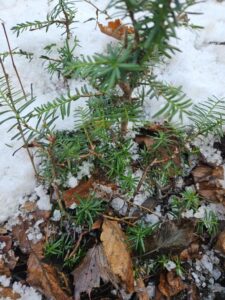 The small and unnoticed play a large role in the functions of nature. I realize that is a theme we teach over and over, but it is a fact of which we naturalists are constantly reminded. Majestic large trees and animals are wonderful to see, but they could not exist without the help of their smaller counterparts which keep the whole world running. At Woodland Dunes, we strive to keep all of nature’s pieces intact, like those in an impossibly large jigsaw puzzle. Sometimes we lose a piece and it causes us a lot of concern. In the early days of this place, extensive surveys were done, recording as many plant and animal species as could be identified. We now compare what we see to what was seen 50 years ago. Sometimes it’s a bit depressing to do so- species that were once regularly found then haven’t been seen for years. And once in a while, we find a plant or animal that has been here but hasn’t been detected.
The small and unnoticed play a large role in the functions of nature. I realize that is a theme we teach over and over, but it is a fact of which we naturalists are constantly reminded. Majestic large trees and animals are wonderful to see, but they could not exist without the help of their smaller counterparts which keep the whole world running. At Woodland Dunes, we strive to keep all of nature’s pieces intact, like those in an impossibly large jigsaw puzzle. Sometimes we lose a piece and it causes us a lot of concern. In the early days of this place, extensive surveys were done, recording as many plant and animal species as could be identified. We now compare what we see to what was seen 50 years ago. Sometimes it’s a bit depressing to do so- species that were once regularly found then haven’t been seen for years. And once in a while, we find a plant or animal that has been here but hasn’t been detected.One such plant is the American Yew, or Canada Yew (Taxus canadensis). This small, evergreen shrub was noted in our original surveys and again a couple of decades ago by a botanist looking at clubmosses in our preserve. However, the exact locations were not recorded and were not remembered, so our staff has not been able to keep track of them. A few weeks ago, however, two of our staff were working to remove invasive Japanese barberry, and in the middle of a large patch found a single yew. They caged it in chicken wire, took photographs, and brought back a small branch for verification. We consulted with other botanists, and confirmed that it was Canada yew. Then the same crew found two more small plants in the same area. All had been heavily browsed by deer, and were perhaps saved by the growth of invasive barberry (which eventually would have outcompeted the yew).
Canada yew was once widely found in Wisconsin. It is a low shrub a couple of feet tall. It is a slow growing plant which despite its poisonous nature is heavily browsed by deer. Yes, the plant is toxic to them, but they eat it anyway. It contains a substance or substances called taxine which slows heart rate in animals. A half pound of yew needles are enough to kill a horse. Maybe deer feel relaxed after eating it- who knows? And yes, it is toxic to humans, and people do use the needles of some evergreens for making tea, so it is good to be sure of the identity of the plant you are using for your brew. It also contains another substance called taxol.
Yew is low-growing, usually a couple feet tall or less. It has flat needles resembling those of balsam fir, but the needles are green on both top and bottom, without the whitish lines of balsam on the undersides. Needles are about an inch long, much longer than those of hemlock. Both balsam fir and hemlock are upright trees mainly, unlike the low, sprawling nature of yew. Common juniper is another low evergreen, but has sharp spiky needles rather than soft flat ones. Its fruit is a red berry-like structure surrounding a single seed. The red flesh of the berry is the only part of the plant which is not toxic (but the seed is!). Japanese yew, which is similar in appearance is a cultivated plant from Asia which looks like our native yew and is often planted ornamentally. It does not seem to be invasive here, but deer like to browse it just like the native species.
Canada yew has disappeared from much of Wisconsin as the deer herd has increased. People love to hunt, and so deer are managed to be plentiful. The impact on forest plants, however, is significant. The three little yew that we found have all been caged so they can survive in the face of pressure from deer. This year we erected two small deer exclosures in the preserve, fenced to a height of seven feet or so. The intent is to protect planted native shrubs and wildflowers. Next year we will be putting up a half acre exclosure in the forest, inside which we will plant more vulnerable species like Canada yew. If funded, we have proposed a nine-acre exclosure in a mature forest area, where many spring wildflowers will be planted. It will be valuable to study such areas in the future, as we decide how to manage deer in the long term.
In the meantime, a missing piece of the jigsaw puzzle of life here has been found, and we are very happy for that. Finding a lost species, or a new species in our preserve is one of the ultimate rewards for managing a natural area. It’s the preservation of living history that motivates us, along with sharing the joy of those discoveries and their meaning with others.
